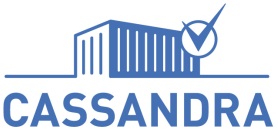The CASSANDRA project: where is my cargo at?
How can we obtain more information about containers, their cargo, location and status during transport? Business and government are looking for ways to increase operational efficiency and effectiveness. Higher quality information should enable more advanced risk assessment, thereby increasing security in the supply chain.

Logo Cassandra.jpg
Project CASSANDRA, short for Common assessment and analysis of risk in global supply chains, will in part be carried out by researchers and PhD students from RSM and <link erim research centres smart_port _blank>Erasmus Smart Port Rotterdam. The last being a notable participant, as they specialise in maritime and port related research.
Increasing the visibility of cargo
The CASSANDRA concept will improve the visibility of cargo through the supply chain by combining E-Freight and E-customs. The three-year project started on June 1 this year. It is funded by the European Commission’s Seventh Framework programme for Security and involves 27 innovative industry leaders. The consortium includes leading companies in the fields of logistics and IT. Amongst them are worldwide players such as DHL, GS1, IBM and Kühne+Nagel. Customs and other border inspection agencies, European research institutes, as well as the port communities and trading partners of the European ports of Rotterdam, Bremer-haven, Barcelona and Setúbal are participating. All members will utilise their specific expertise in this € 15 million project, which builds on the previous projects funded by the EU, such as SMART-CM and ITAIDE.
Improving risk-assessments
Government authorities currently perform risk assessments using the traditional Transaction Based Audit (TBA) approach. Each cross-border trade transaction is inspected individually, based on declaration data submitted to authorities (‘data push’). RBA identifies secure and known container flows based on System Based Auditing (SBA) in which government authorities use data and risk assessment of businesses for their own risk assessment. This re-use is the concept of piggy-backing. CASSANDRA aims to bring the Risk Based Audit (RBA) approach to the next level.
So with SBA, governmental organisations assess business processes and protocols with accessible business data (‘data pull’). The effectiveness of control improves when the trusted flows are dealt with cost-efficiently, thus providing more opportunity to investigate and address riskier container flows. Businesses benefit directly from improved visibility in the supply chain, leading to reduced administrative burden and errors as well as less interference from cross-border inspection agencies.
What will CASSANDRA do?
CASSANDRA will achieve interoperability of heterogeneous systems by using state-of-the-art IT innovations to form a data pipeline, so that secure and reliable data can be shared across the supply chain. Different levels of data access will be defined for different partners in the chain including cross-border inspection agencies. The data pipeline is investigated and demonstrated with Living Lab case studies for three global trade lanes: China-EU, EU-US and EU-Africa. The CASSANDRA interoperability approach will be aligned with other international eFreight and eCustoms initiatives and international standardisation and legislation bodies thus taking the first steps towards global implementation.
CASSANDRA and Erasmus University Rotterdam
Erasmus University is involved in the CASSANDRA project via researchers and PhD students from RSM Erasmus University and the maritime research centre <link erim research centres smart_port _blank>Erasmus Smart Port Rotterdam. The main activities entail the analysis of user requirements, the development of a methodology for risk-based approach,the improvement of data enhancement and business intelligence, managing a Living Lab from Asia to Europe, and consensus-building activities via stakeholder involvement and engagement.


